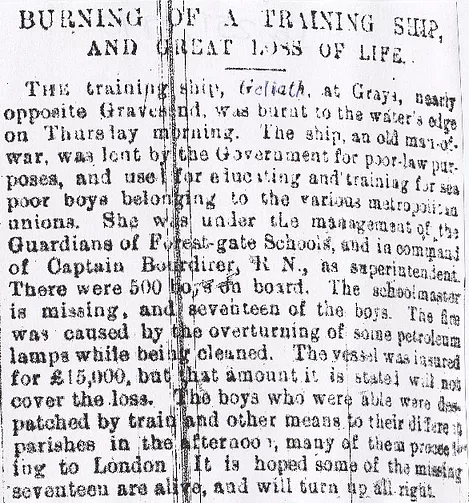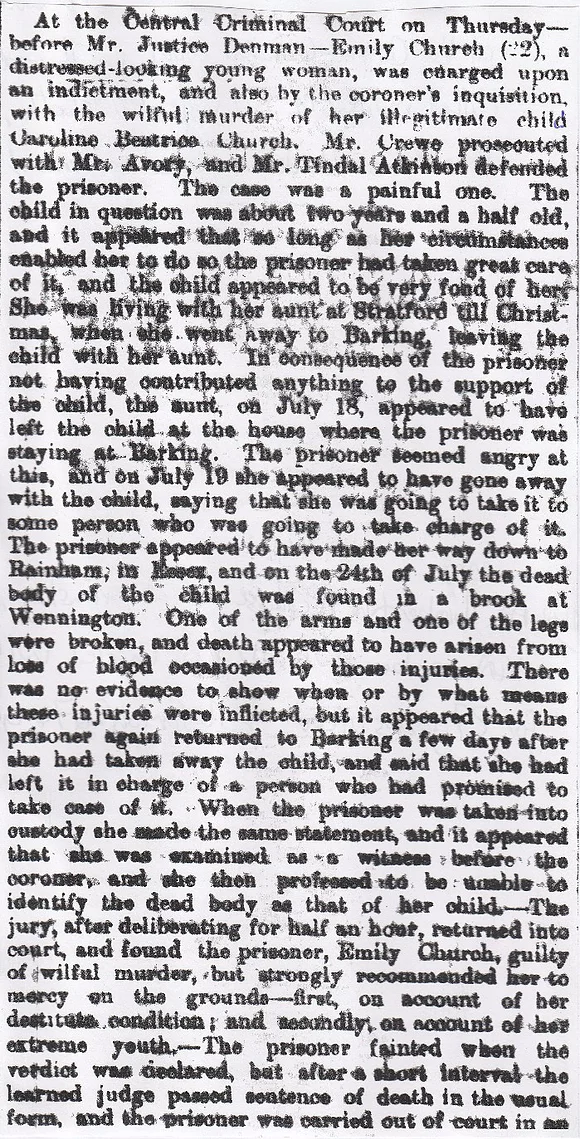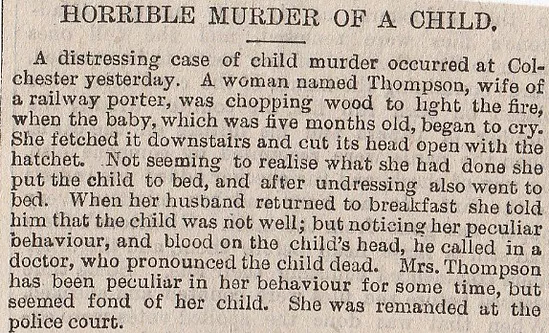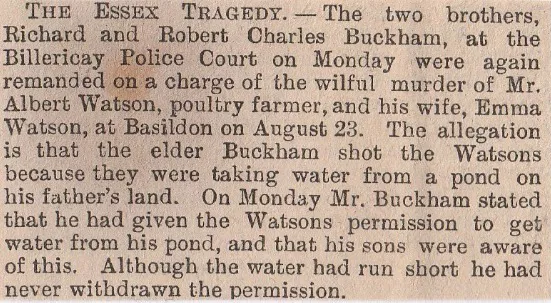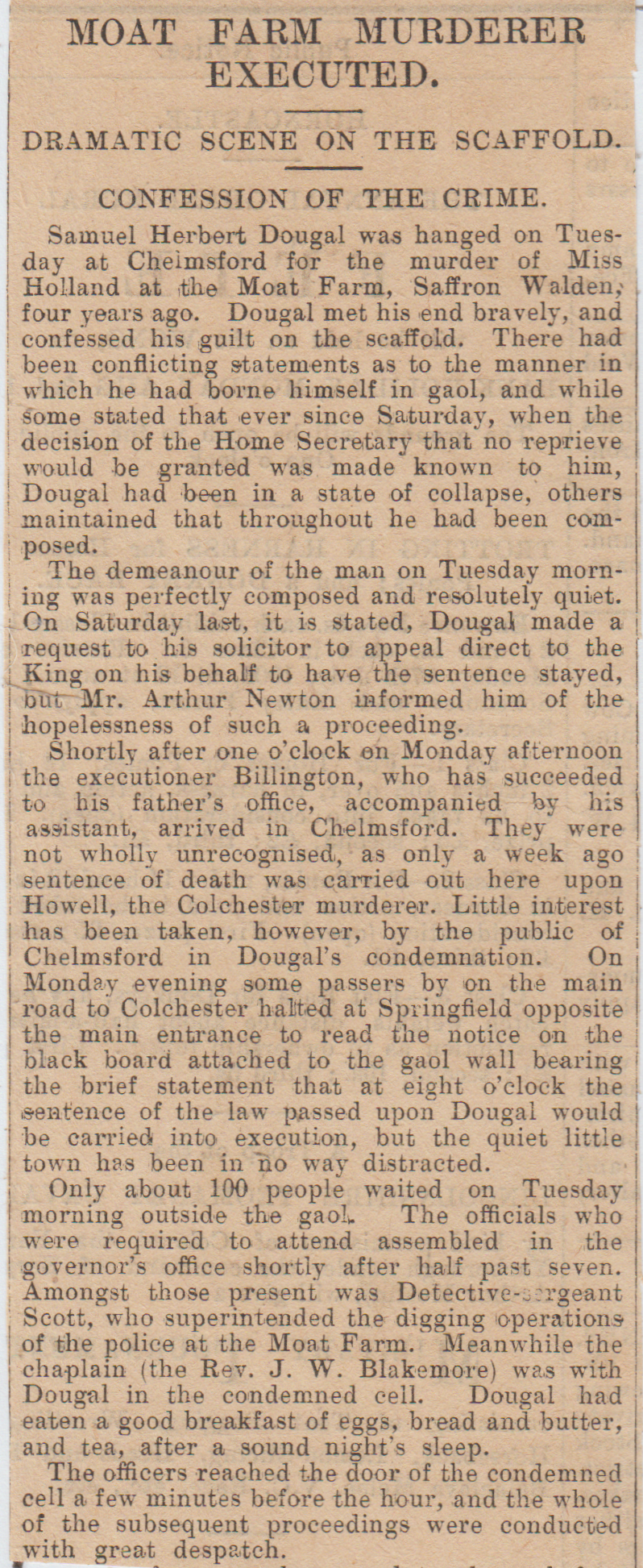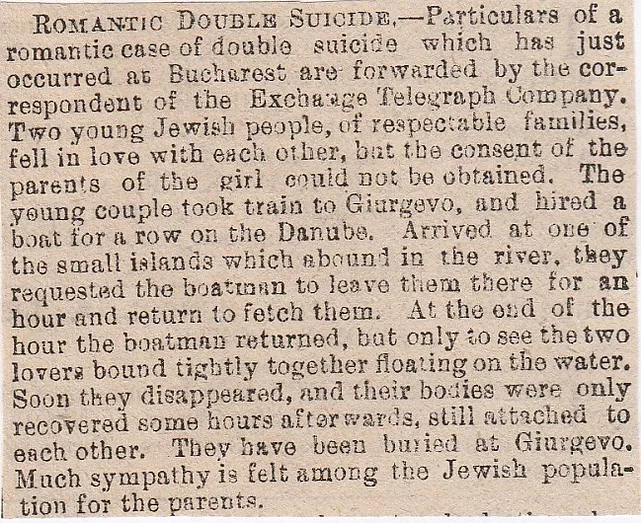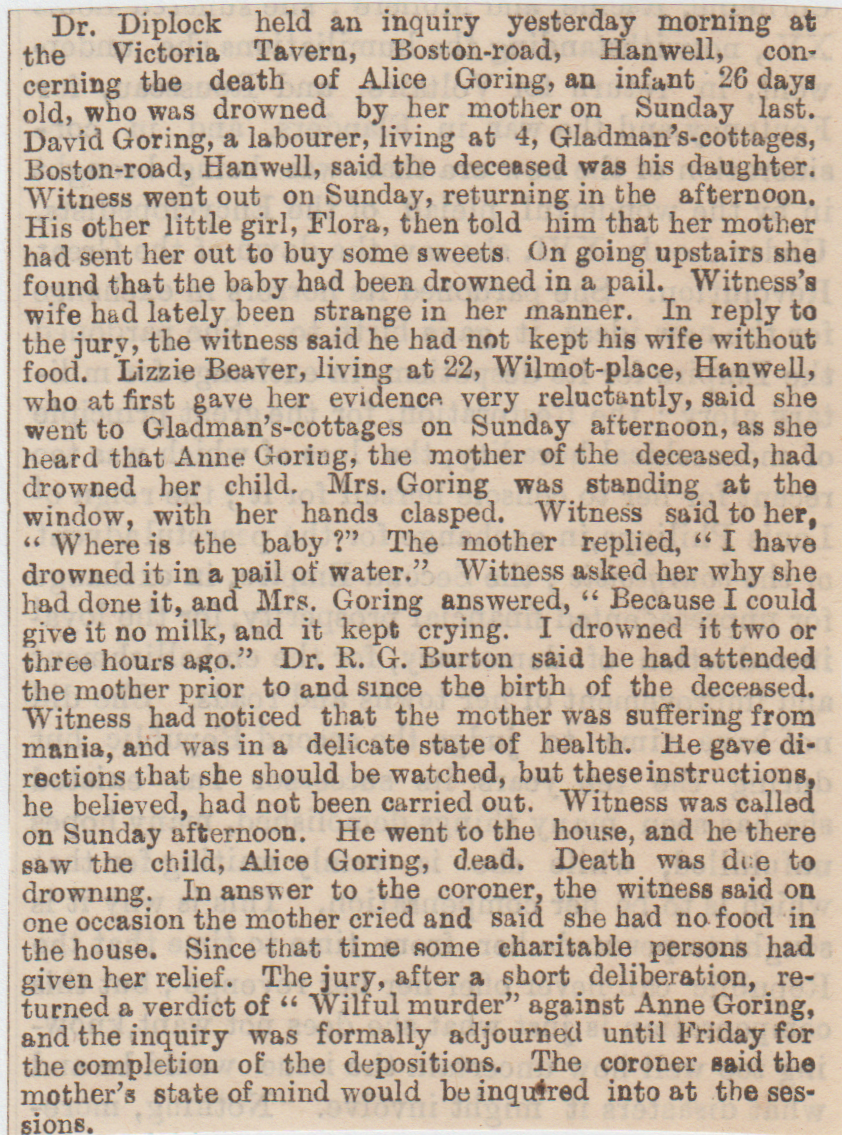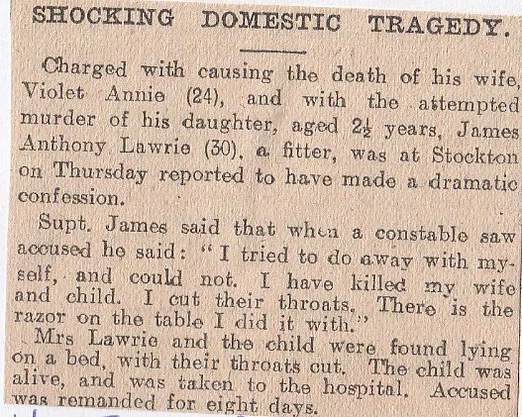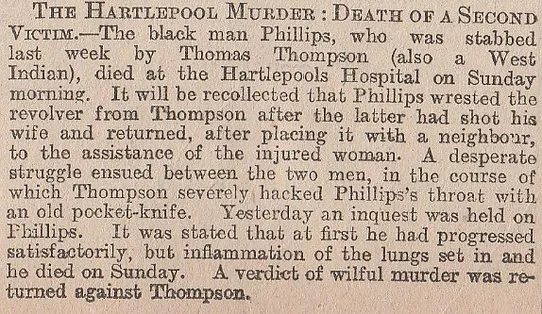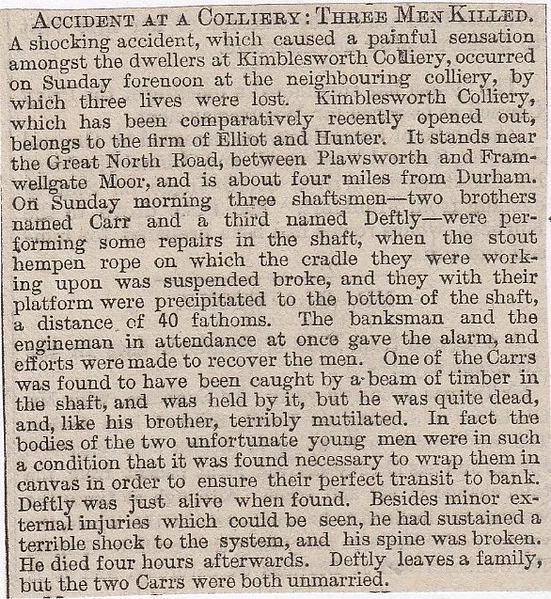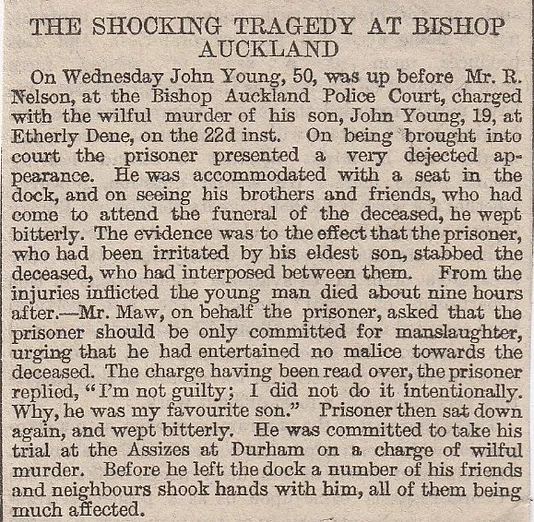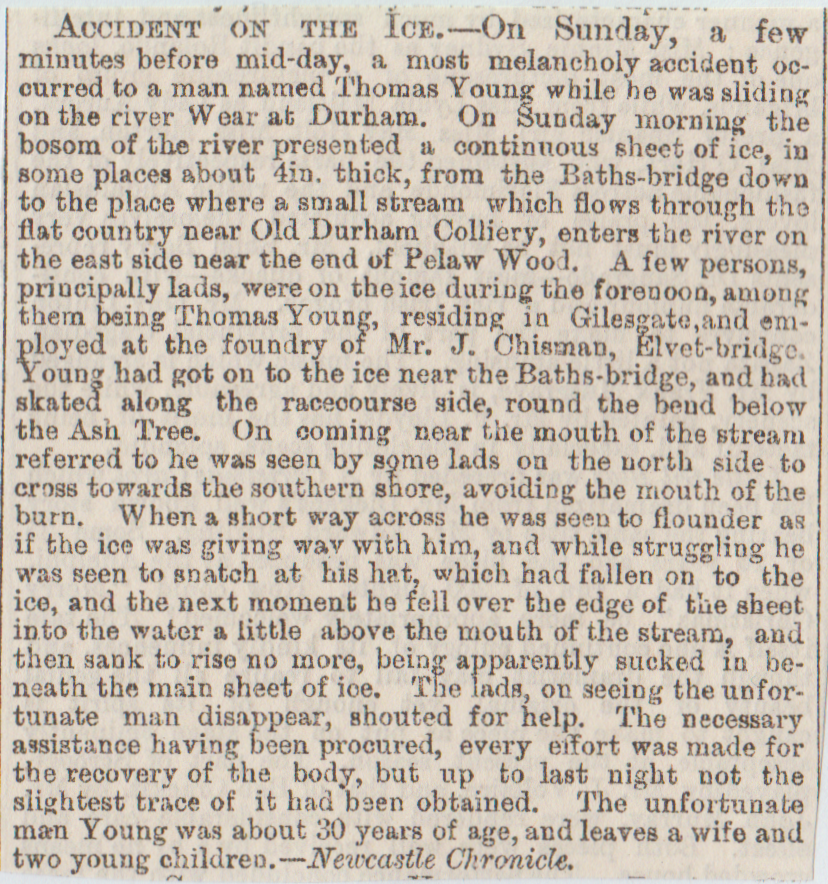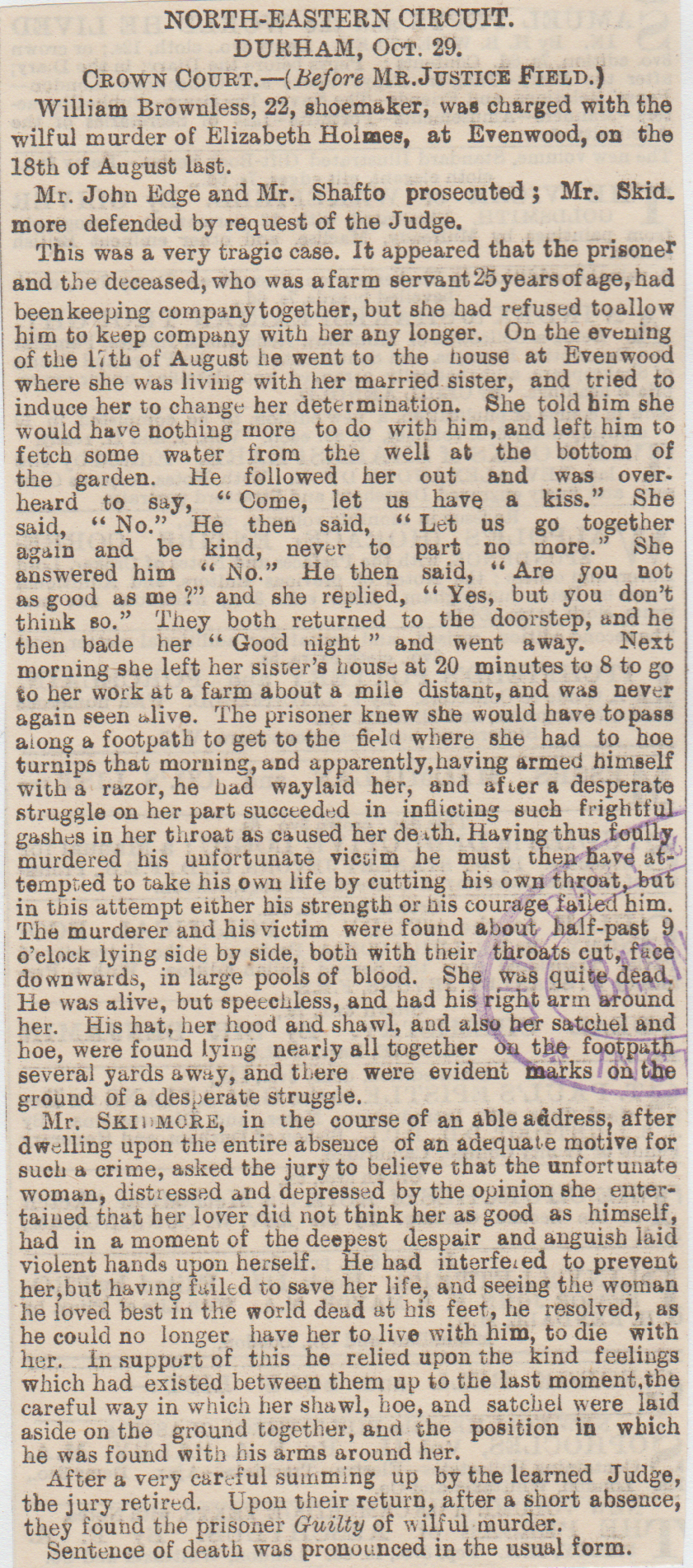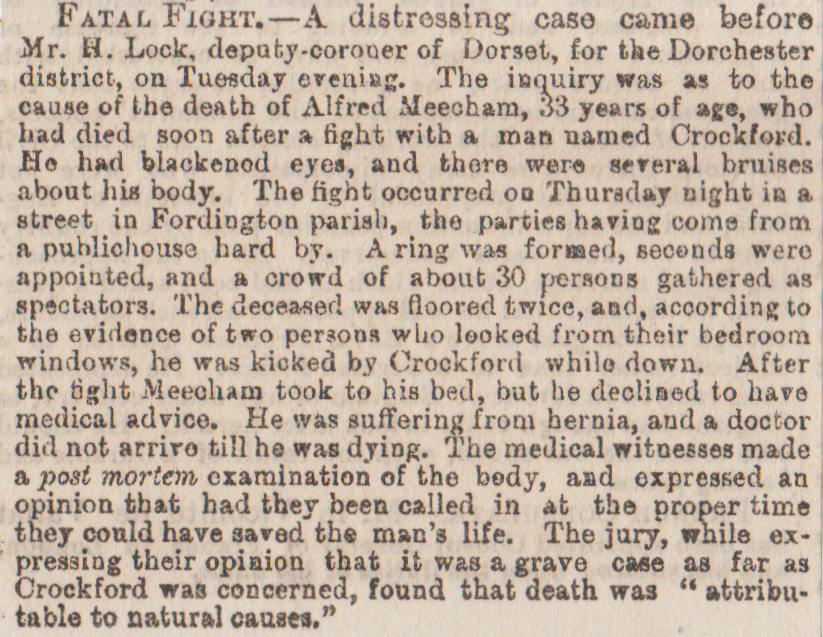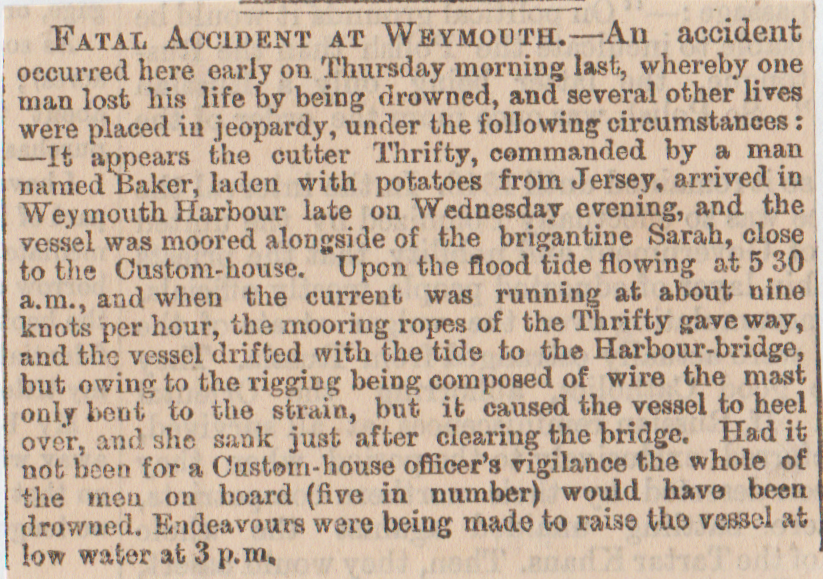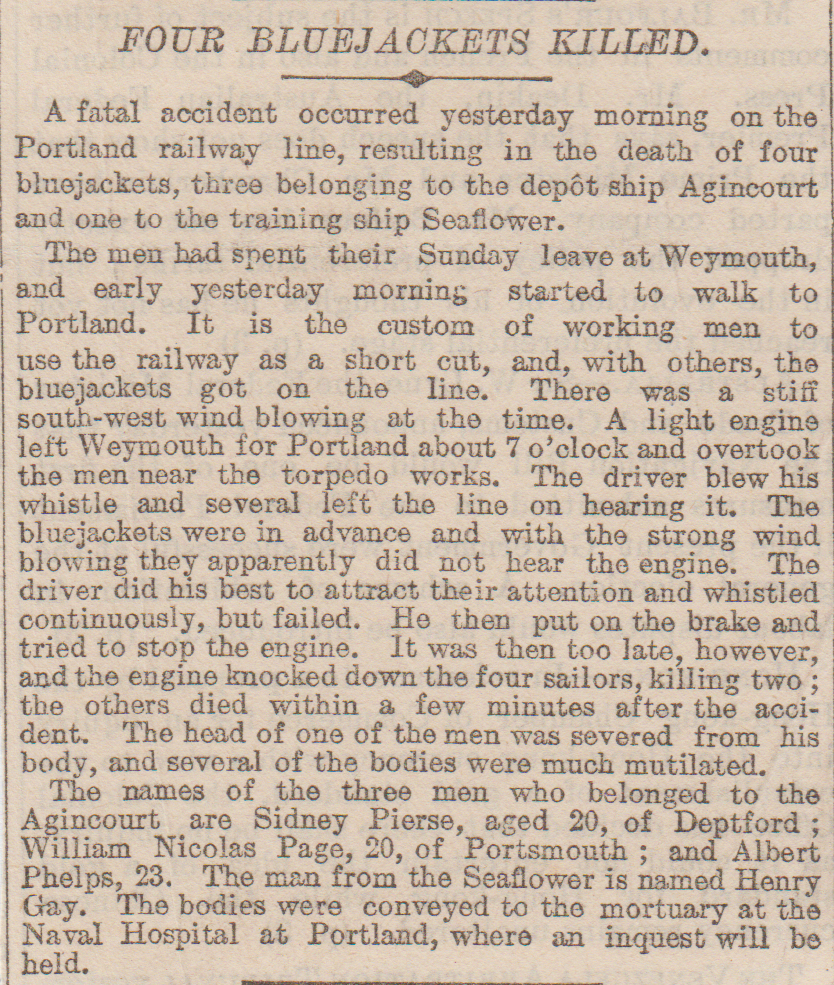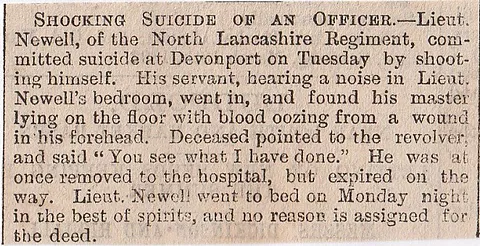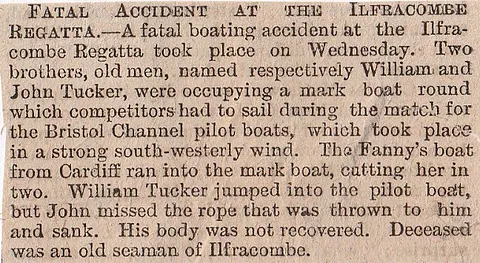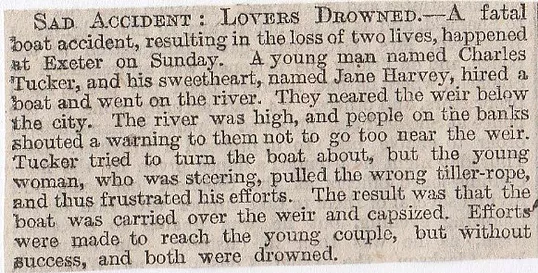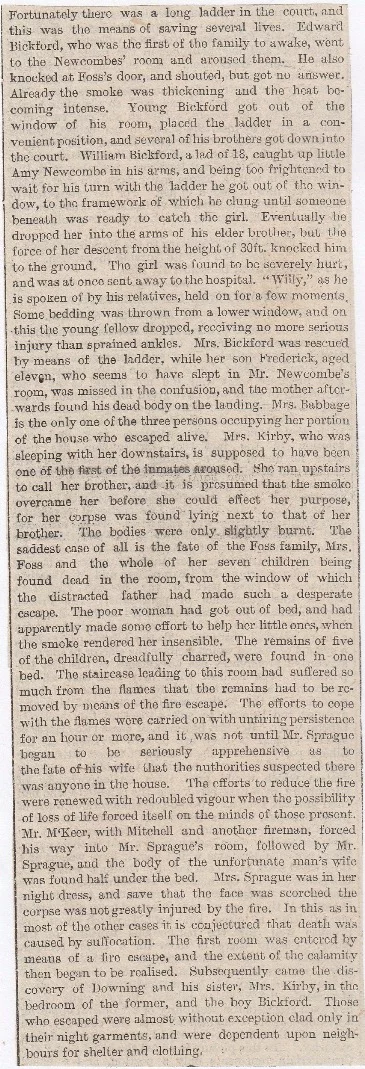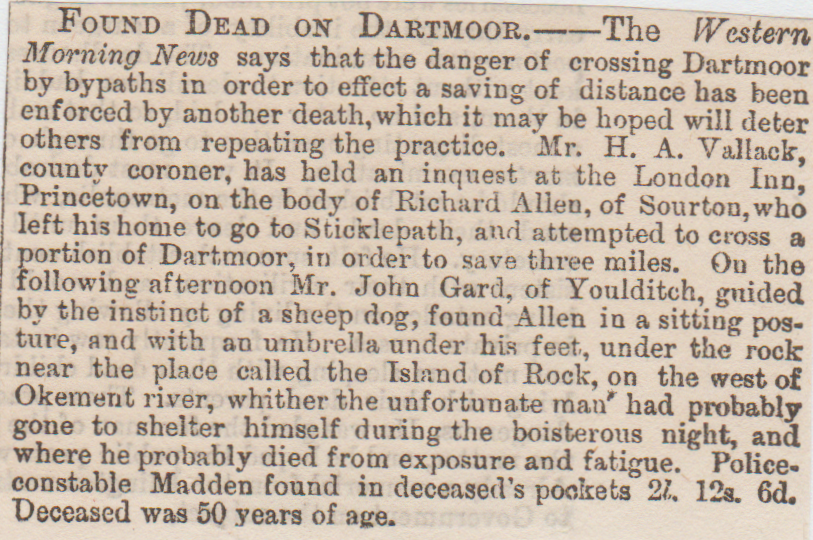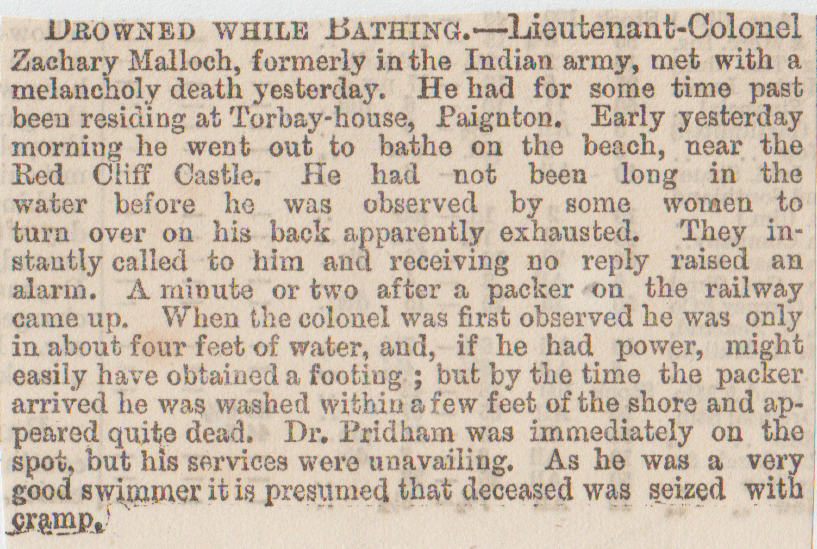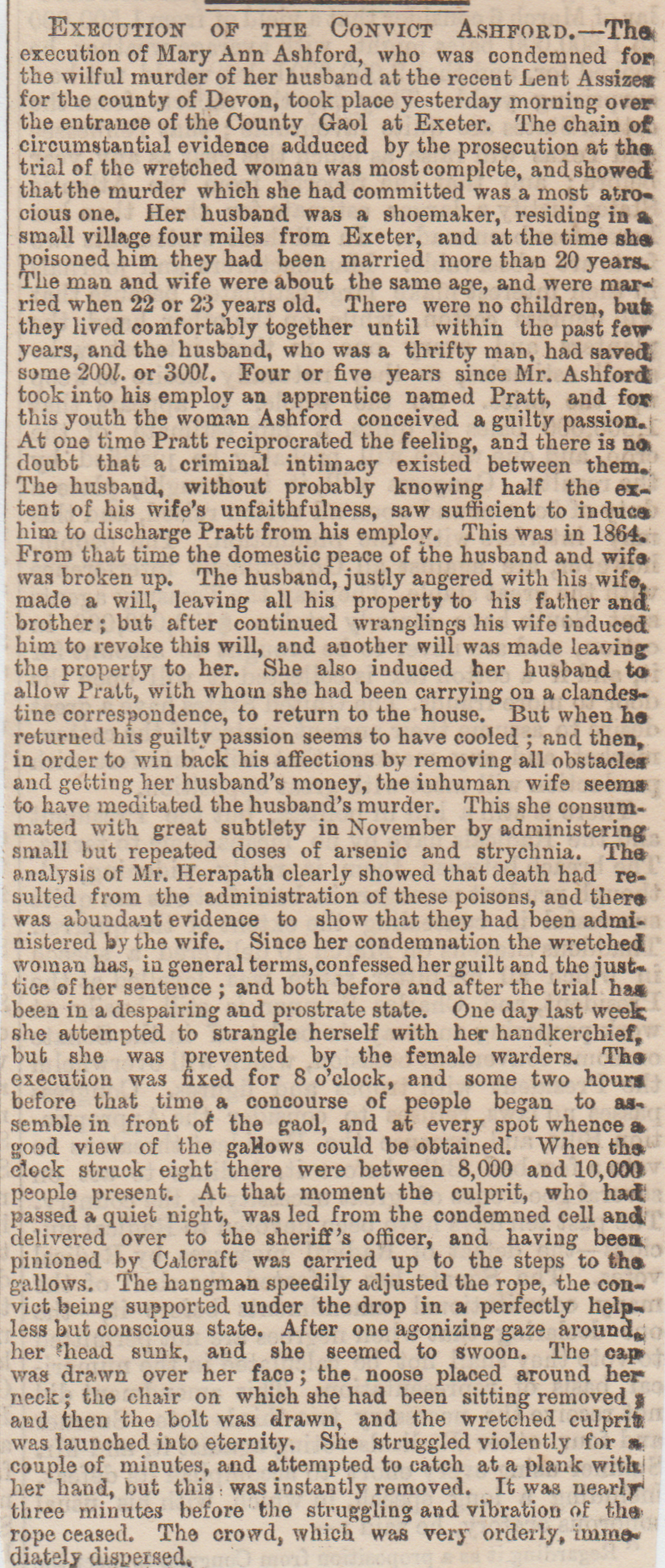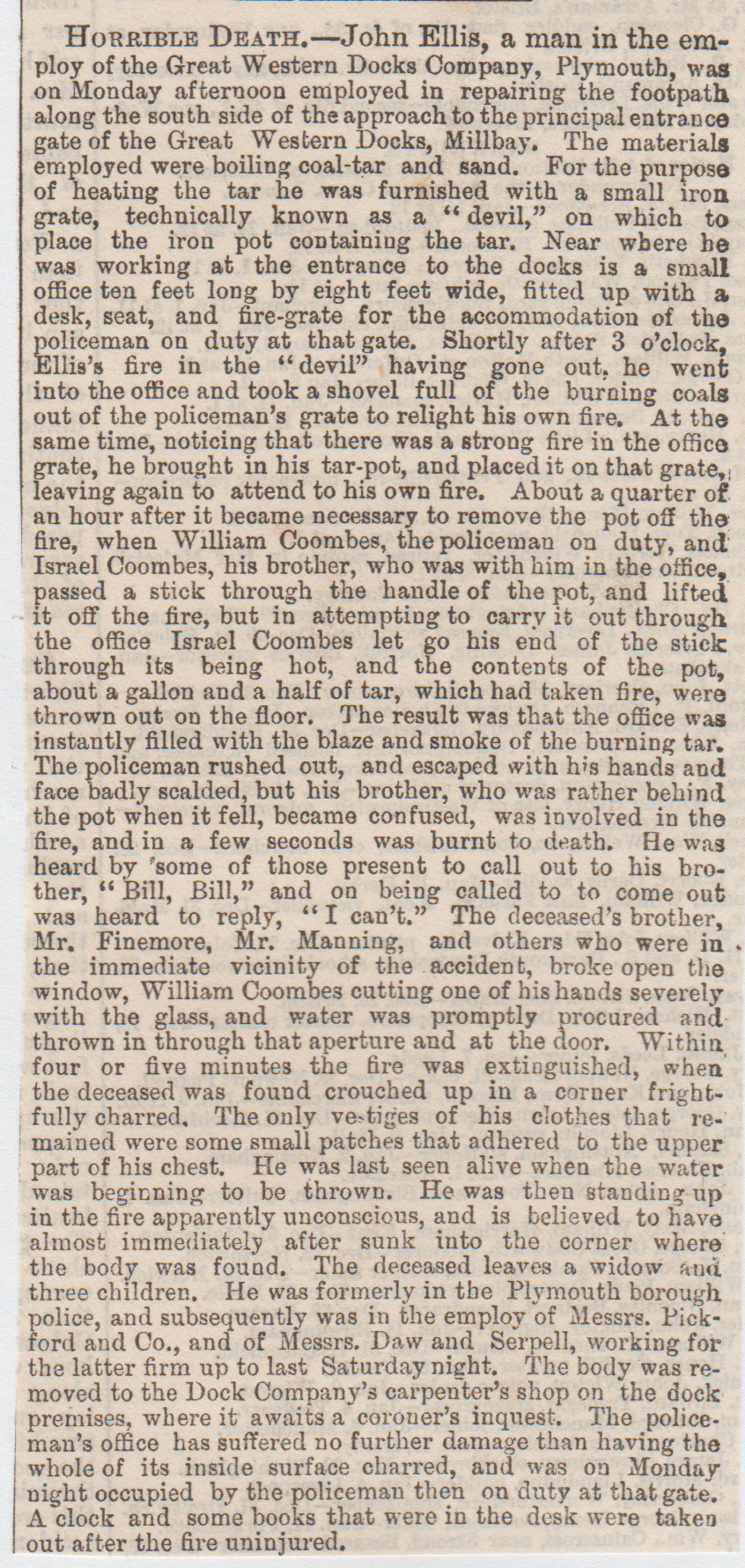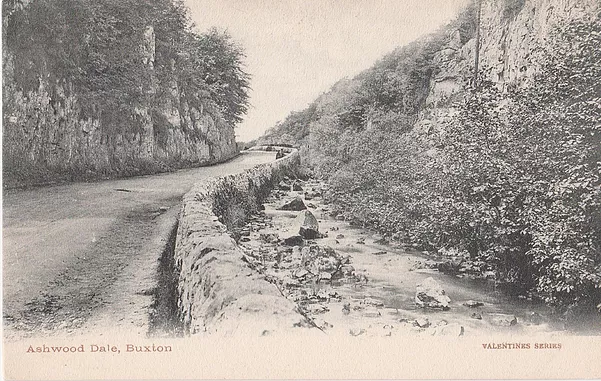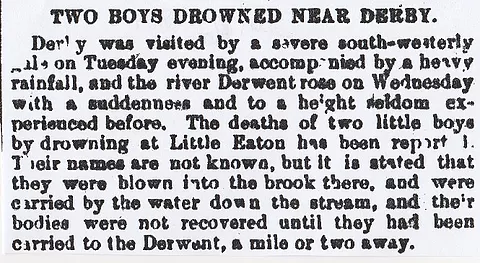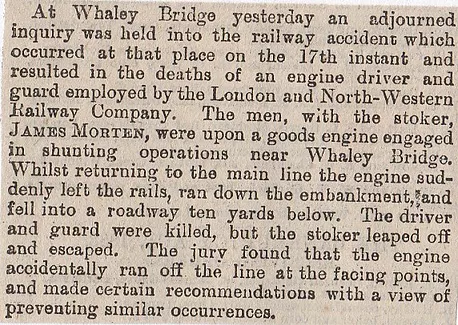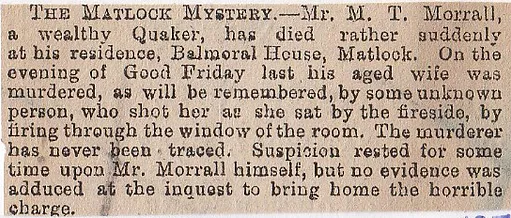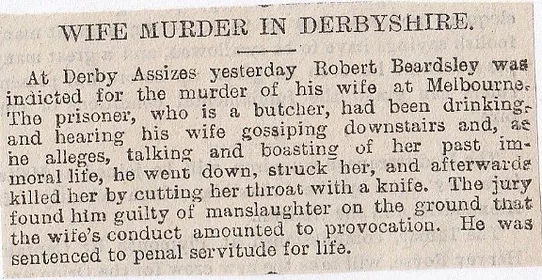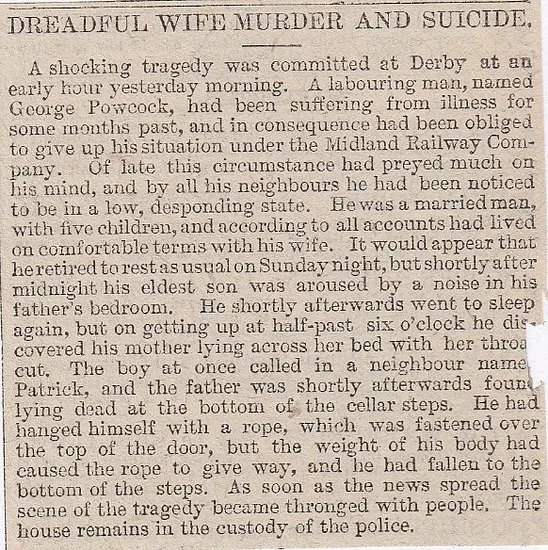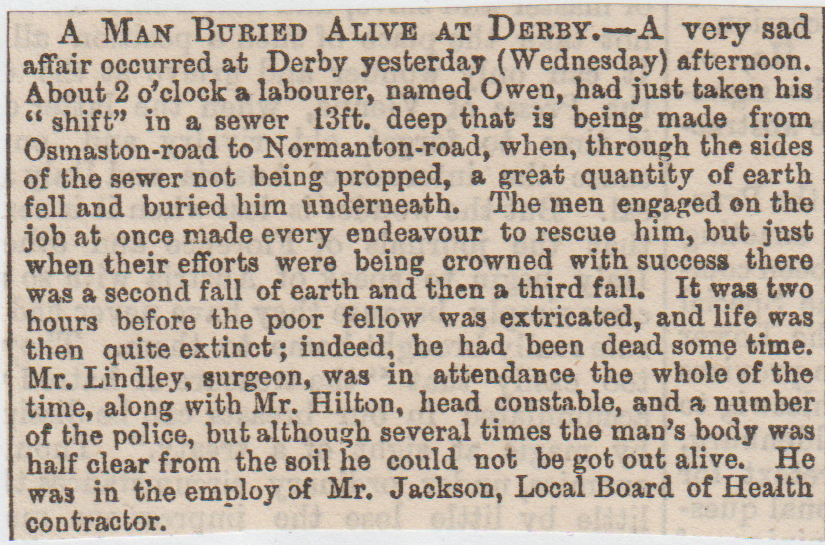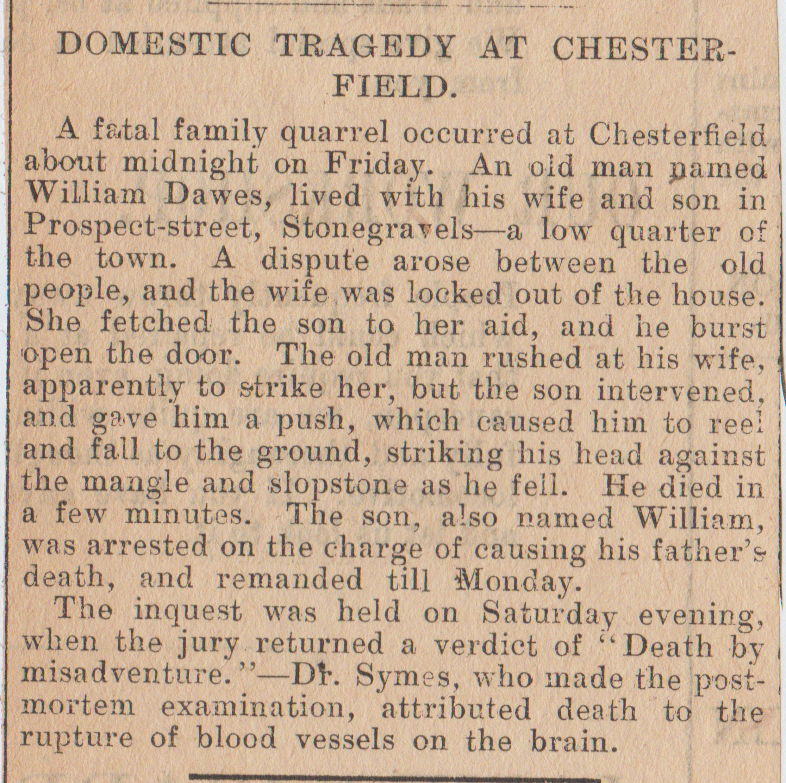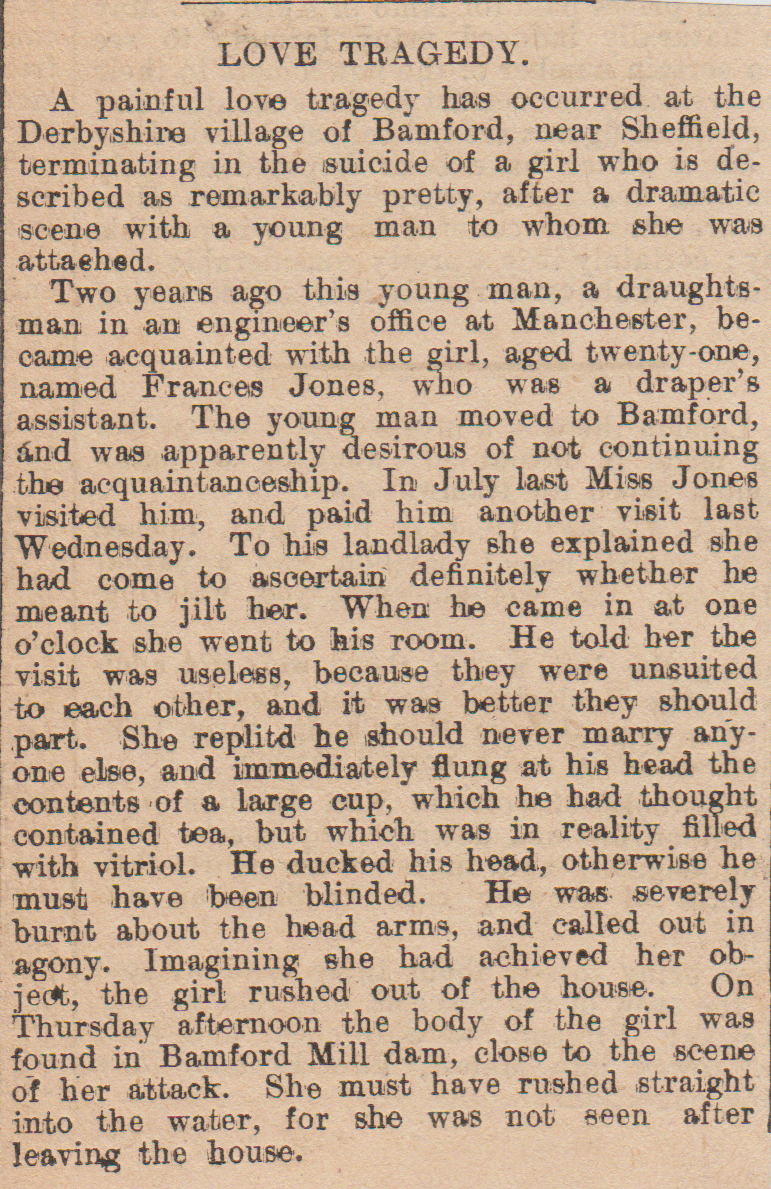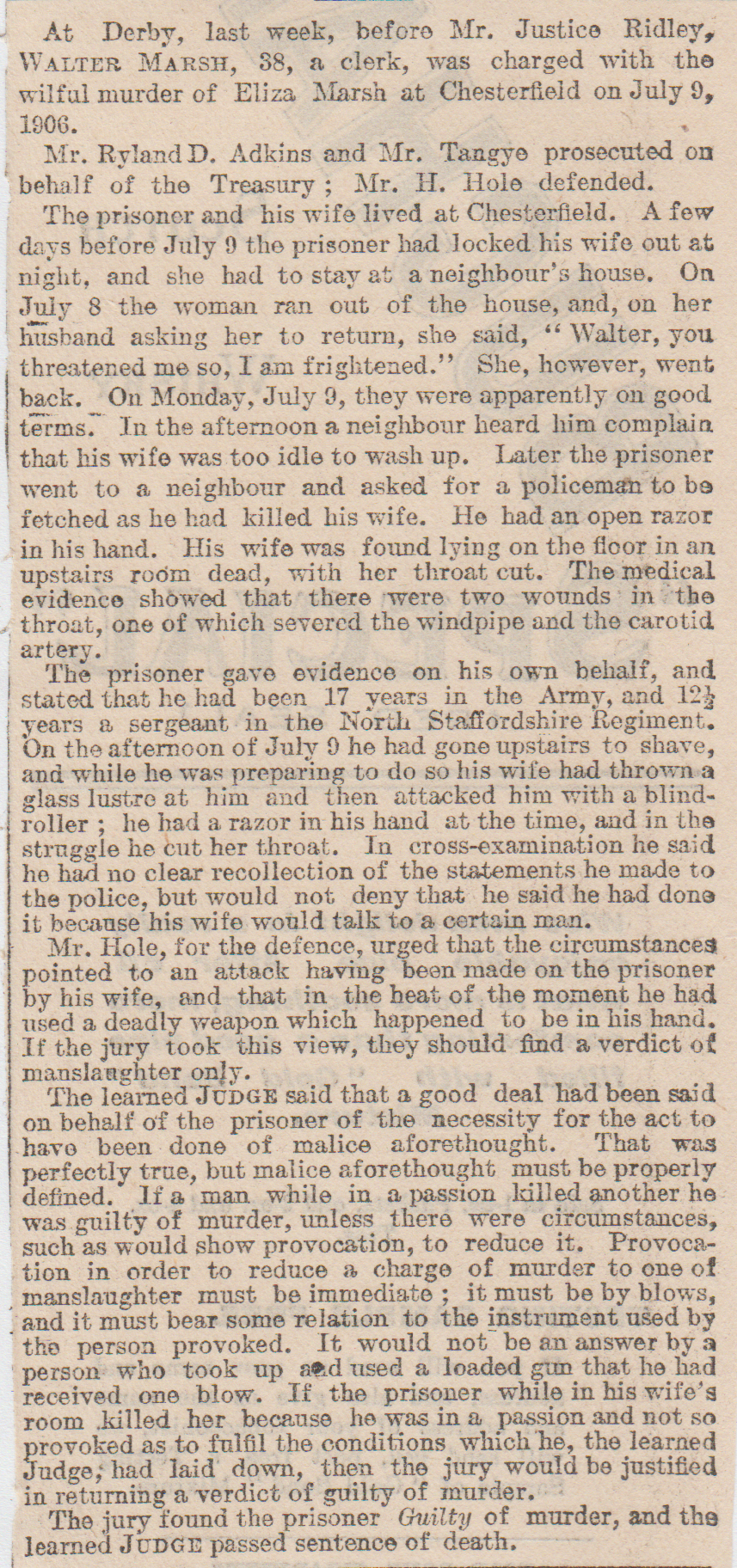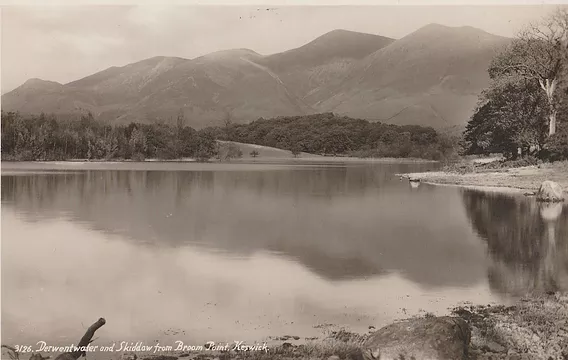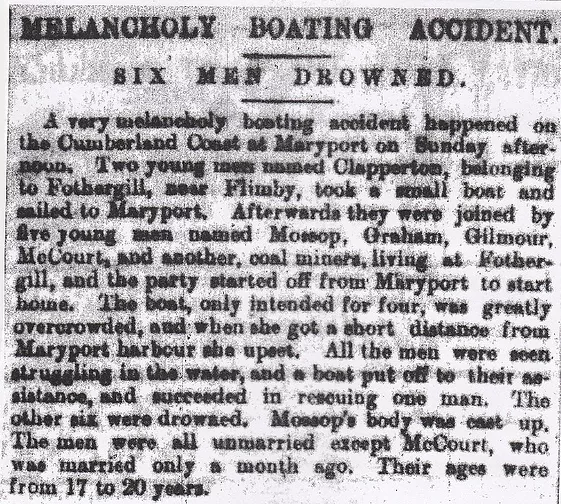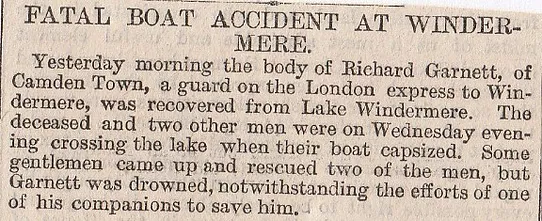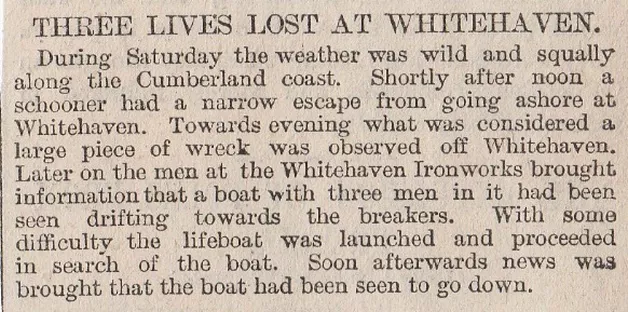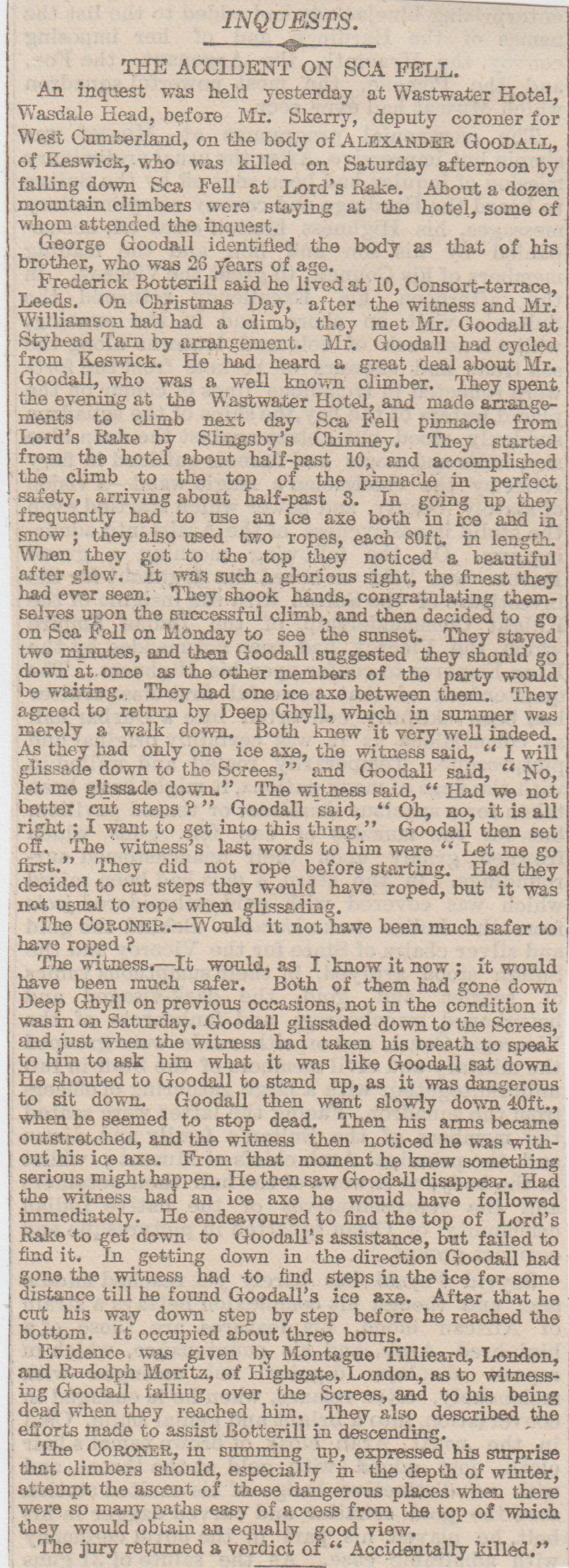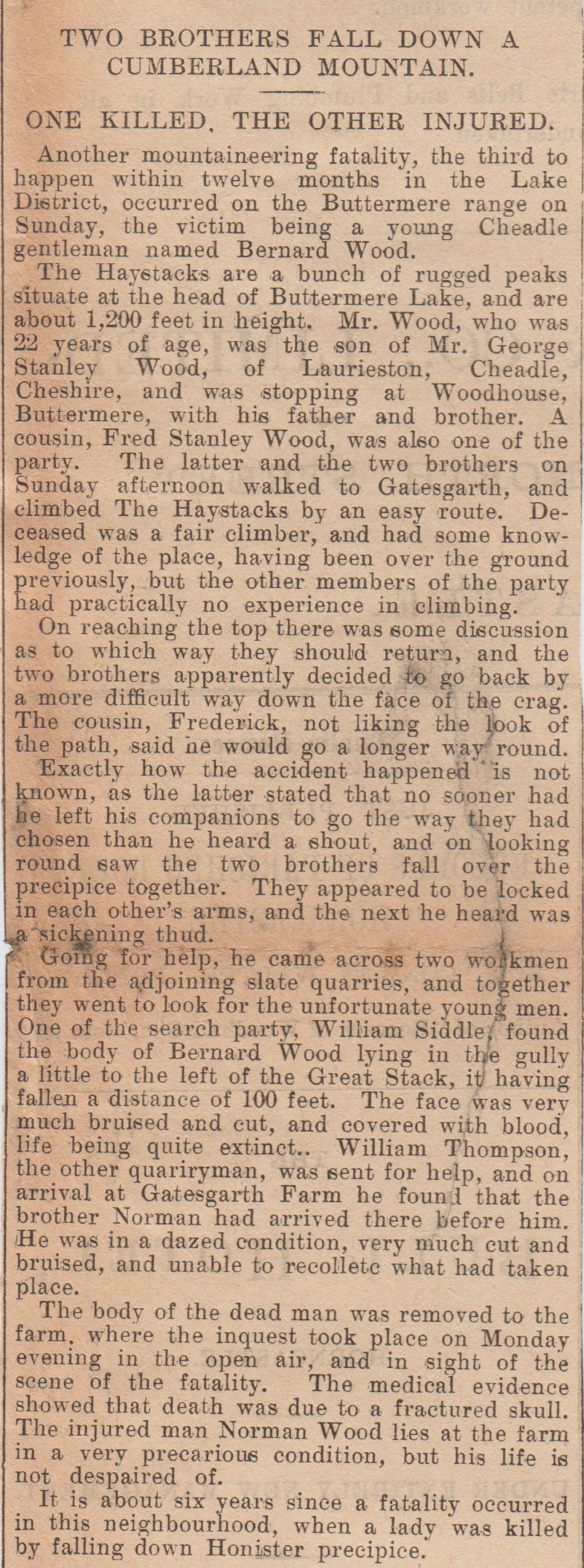1/ Saxony Dynamite Suicide, Germany, December 1880
In Schwarzenburg a young man enters a ballroom with a cigar in his mouth. Nothing unusual so far, until he lit it and there was a tremendous explosion and chandeliers rocked, pictures fell and bits of the young man were dispersed over the crowd. The cigar was a stick of dynamite and this was a sure-fire way to end his life. Won’t forget that night in a hurry!
2/ Lleida, Spain, (Pulls Out Own Intestines) March 1868 (Between Zaragoza and Barcelona)
A man was brought into the hospital with terrible self-inflicted injuries. He had locked the door of his room, sliced open his stomach and ripped out his intestines and proceeded to chop them to pieces and throwing them about the room. He unlocked the door, then called his wife to come to his aid. He told hospital staff that he’d had violent stomach cramps and this was his cure. He died next day.
3/ Granada Church Suicide, Spain, September 1909
During a Sunday night service, a man took out a gun and put the barrel in his mouth and pulled the trigger. There was mass panic and church-goers began to run for the exits, they pushed and shoved each other out of the way.the men climbed the windows, breaking stained-glass and smashing icons. When everyone was out the church looked like a bomb had hit it. There were no casualties but a few women and children have life-threatening injuries. (What church?)
4/ Switzerland, March 1879 (Chaux-de-Fonds is right on the border with France. Anybody who murdered somebody here could have been in France in ten minutes.)

5/ Hinterkaifeck Murders, Germany, March 1922
This is Germany’s equivalent to the Villisca Axe Murders in America, a whole family wiped out by supposedly by a lone killer.
Andreas Gruber aged sixty-three and his wife Cazilia aged seventy-two and the maid Maria Baumgartner in her mid-forties and finally the three children; Viktoria aged thirty-five, a widow; Josef, who was only two and Cazilia, seven-years-old, were the victims of a cool calculated murderer. The strange thing is about this case is that there was a sort of warning beforehand, inasmuch as the fact that Andreas saw footprints in the snow suggesting that someone was scanning the property first. Keys went missing and footsteps were heard in the attic, so was someone already in the house to start with?
Rather unluckily Maria the maid only started work on the same day she was slain, the other maid left rather quickly saying the place was haunted. The really freaky aspect of these murders is that after going around slaying them, the killer stayed on for a few days. He (or she) helped themselves to the bread, cheese and meat, they lit a fire (smoke was seen by neighbours from the chimney) and continued as if nothing had happened by feeding the cows. For the person who had just killed four adults and two kids, it was a sort of weekend break for them! (Unsolved still after nearly a hundred years)
6/ Schonewalde, Konigsberg, Germany, (Triple Murder/Suicide) December 1882
A shocking tragedy is reported from the village of Schonewalde near Konigsberg. On Thursday night a woman of that place, in a fit of insanity threw her three children into a deep well at the back of her dwelling-house. She then set fire to the outbuildings and afterwards herself leapt into the well. The next morning the four corpses were taken out.
7/ Sicily, Italy, May 1884 (This article mentions a group of murderer’s in Sicily. Who could that be? Mafia?)

8/ Milan Cathedral Suicides, August 1868

At Milan a few days ago, a woman precipitated herself from the front of the Cathedral and was killed instantly. A young man of eighteen, a lithographer, who was passing, immediately entered the building saying he wished to see the spot from which the woman had thrown herself and exclaiming “There is a woman who has freed herself from all annoyance” and ascended the tower. Having written a few lines to his brothers on the stone parapet with a pencil, he jumped off and met with a sudden death. In falling he knocked down and seriously injured a Prussian Major, Count Henckel, who was passing at the time.
9/ Vienna, Austria, April 1866 (Quintuple Suicide)
Not very often you see those two words next to each other, as five people all deciding to end their days, by poisoning themselves, it seems odd to most but this is continental Europe and I noticed that the suicides and murders are more dramatic and seemingly more theatrical. The instigator of the suicides was M.Tuvora a 50-year-old Austrian entrepreneur of the railways’ system. He left work one day saying that he had to attend to some business and let his clerk get on with the paperwork and then went home to dinner. He had five children in total and spared the youngest two, by sending them to his fathers-in-law. The weird thing is, that the other three stayed to join in this suicide pact. They all had dinner, then he went for a walk with his 35-year-old wife, then went back home. The servant, who had dropped the kids off at the relative’s house, tried to get in but found all doors locked tight. The police forced the door open and were met with a truly horrendous sight. They were all at the dining-room table, some on the floor and with half-empty teacups on the table. M.Tuvora was an extremely unhappy man and the others said that if he was going to kill himself they would go with him.
10/ Flushing Railway Deaths (Vlissingen) Netherlands, June 1899
A fatal accident occurred here when owing to the failure of the pneumatic brake, when a mail train ran through the waiting-room, shattering walls and doors. Two guards were killed and the two drivers were severely hurt.
11/ Grand Hotel, Stockholm, Sweden, (Mass Panic) September 25th, 1885

12/ Grand Hotel, Stockholm, Sweden September 30th, 1885

13/ Mulligen, Switzerland, April 1885
The village of Mulligen, in the Swiss canton of Aargau, has been entirely destroyed by fire.
14/ Geneva Murder/Suicide, Switzerland, August 1885
A woman named Gentel was murdered in Geneva on Sunday evening by a labouring man named Tournier, who himself committed suicide immediately afterwards, in front the corpse of his victim. The motive alleged for the crime is that the woman had refused an offer of marriage from Tournier.
15/ Navarre, Spain, (Wolves Kill Three) January 1882
In the clipping, it says this occurred in Uvarre in Spain, but I cannot find it. Presumably, they meant Navarre. The Christmas Eve service in Navarre (Uvarre?) was taking place when a pack of wolves entered the church and did not quit until they had killed three and seriously injured another five of the congregation.
16/ Vienna, Austria, May 1885 (Execution Cock-Up)
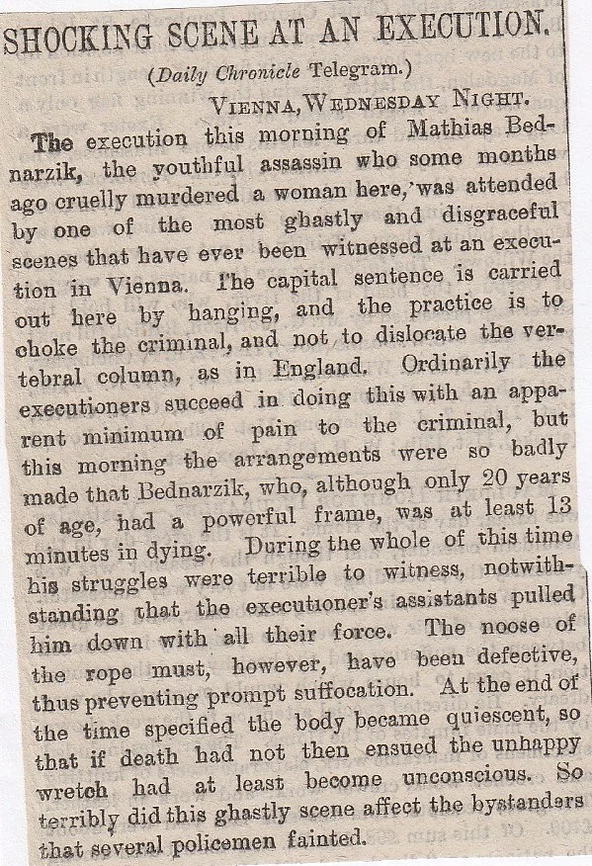
17/ The Crossword Puzzle Murder, East Germany- 1970’s
The Crossword Puzzle Murder is, I hate to use the word, favourite of all the murders I’ve read about. I normally like the unsolved crimes, such as Dyatlov Pass, D.B.Cooper, Escape from Alcatraz, Hinterkaifeck, Servant-Girl Annihilator, Bella in Wych Elm, Charles Walton Murder in Warwickshire, etc etc. This one was solved but the sheer man-power involved was incredible. Don’t forget they had no hi-tech computers helping them or DNA testing. It was just good, honest policework that helped them solve this. The body of a young boy was found dismembered in a suitcase by the side of a railway line. It had been thrown off a passing train by the perpetrator. It was determined that the boy had been molested but with no DNA in those days, it was pointless. The one clue they did have was a sample of his hand-writing, as he had left a filled in crossword puzzle on the newspaper that he lined the suitcase with. The police, along with Stasi help.went round houses and got the citizens to give an example of their handwriting. They then searched police records and emptied the bins and rifled through tons of rubbish, for months on end. Eventually, they got a match and arrested the man for the boy’s murder.
18/ Morges Murder, near Geneva, October 1885
A terrible tragedy was enacted on Monday at Morges near Geneva. A man literally hacked his wife to pieces, then saturated the bed with petroleum, set fire to it and attempted to escape. Overcome by fumes, however, he sank down and was suffocated. The house was saved from destruction by the neighbours.
19/ Malta (Ship Collision) April 1899
An agent from Malta telegraphed yesterday that the British steamer, Kingswell, has been in a collision with a Greek coaster. The former vessel is uninjured, the latter sank. There were forty-nine persons on board, only four of whom were saved.
20/ Leyden, Netherlands, (Maria Swanenburg) April 25th, 1885

Netherlands April 27th, 1885 (The poisoner was Maria Swanenburg, suspected of ninety murders, twenty-seven died, with several crippled for life. Found Guilty on April 25th, 1885. Died in prison in 1915.

21/ Hamburg, Germany, October 1885
A four-storey house in course of erection at the corner of a street leading out of the Specks Platz, collapsed at five o’clock this afternoon, burying several persons in the ruins. Up to seven o’clock this evening, two dead bodies have been recovered and two men severely injured had been extricated. It is believed that about six others are still under the debris. (What was the death toll?)
22/ Hamburg, Germany, November 1893 (Suicide from Church Tower)
The English church in the Zeughaus Markt at Hamburg, was celebrated with a special service, which attracted a huge congregation. During this service, the sexton climbed the tower and then committed suicide by plunging off the top of it. His body was smashed to atoms as he hit the pavement below. Friends and relatives said that he had been acting strangely of late.
(Is the English church still there?)
23/ Near Rome, Italy, June 1899 (Fall from Balloon)
During some military captive-balloon manoeuvres near Rome, a sudden gust of wind broke the ropes, which were held by forty soldiers. The balloon ascended with great rapidity, with a soldier named Vacca hanging to the rope. When passing over the Tiber the unfortunate soldier fell from a great height and was dashed to pieces on the bank.
24/ Corfu, Greece, January 1890 (Fatal Pub Brawl)
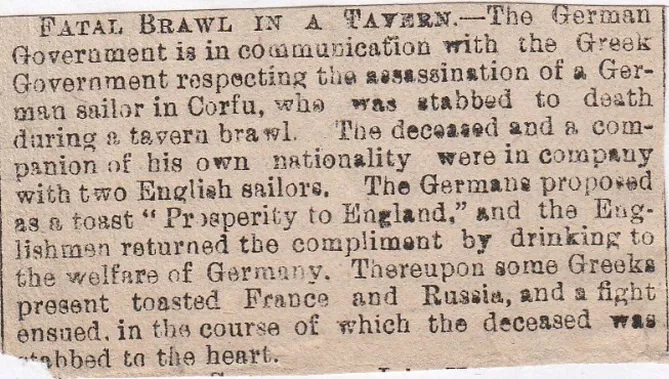
25/ Vienna, Austria, August 1892 (Child Suicide)
A sad case of child suicide is announced from Vienna. In consequence of a beating which he received from his mother, a little boy named Nowotny aged seven threw himself from the fourth floor of a house in the Landstrasse district of the city into the courtyard below, where he was picked up mortally injured. He was conveyed to the hospital but expired shortly afterwards.
26/ Spain/Portugal, (Train Crash) October 1885 (Can’t find this!)
This morning the express train from Lisbon to Madrid ran off the line while crossing a bridge over the River Sever near the Spanish frontier and was precipitated into the river. Some of the passengers were killed and several injured. No further details have been received up to the present.
27/ Namur Triple Murder, Belgium, October 1897
Three persons were yesterday found murdered in a house on the road from the Bois de Villers to Arbre near Namur.They were an old man named Francois Piot aged eighty-four; his daughter, a widow named Biet aged fifty; and the latter’s daughter aged twenty-four. The interior of the house was in great disorder, with robbery appearing to be the motive of the crime.
28/ France/Italy Avalanches, January 1885

29/ Braunschweig Factory Fire, (Brunswick) May 1899
A large warehouse at Brunswick, belonging to Messrs Karstadt and Company, was totally destroyed by fire. Five girls perished in the flames. Several persons were injured, one of whom has since died.
30/ St Gallen, Switzerland, (Anarchist Suicide) May 1885
The anarchist who in February last, addressed a threatening letter to the Federal Government, threatening to blow up the Federal Palace and giving details of the projected plot, has hanged himself in prison. The young man named William Huft, a native of Baden and a hairdresser by trade. Huft, who had only just been arrested, refused to answer the questions addressed to him. He was conveyed to the gaol at St Gallen where he almost immediately hanged himself.
31/ Wiesbaden, Germany, January 1890 (Death of an Englishman in Germany)
The body of a well-dressed and gentlemanly looking figure, probably an Englishman, has been found on the railway near Wiesbaden Station. Four pounds in English money were found in the pockets of the deceased man’s clothing. There were no other means of identification and the circumstances of his death are unknown.
32/ Lausanne, Switzerland, March 1885

33/ Klagenfurt Avalanche, Austria, January 1885
While twenty peasants were driving to market at Klagenfurt on Saturday, an avalanche fell fro a hill and overwhelmed them. Efforts were made to rescue the unfortunate men, but up to last night without success.
34/ Kassel, Germany, November 1885
Lieshe, the man lying under sentence of death for the murder of Police-Councillor Rumpff at Frankfurt-on-Main, was beheaded at eight o’clock yesterday morning by the Berlin executioner. He protested his innocence and met his fate with composure.
35/ Recuerja, Spain, (Rocks Crush Eleven) March 1899
A telegram from Albacete announces that some rocks overhanging the village of Reuerja suddenly fell today, destroying ten houses. Eleven persons are known to have been killed but up to the present, only two bodies have been recovered.
36/ Samos, Greece, March 1899 (British Naval Boat Sinks)

37/ Berlin Clown Suicide, Germany November 1867
Agreat, the well-known clown from America, called the “Man-Fly”, killed himself at Berlin in front of 2000 spectators by firing a revolver in his mouth, while he was hanging upside-down from the ceiling of the theatre by his feet. (Anybody know any more?)
38/ Cartagena, Spain, January 1888 (Suicide by Dynamite…in a Theatre!)
A telegram from Cartagena states that a broker committed suicide while sitting in a stall at the theatre. Not unusual in itself, but the fact he did it with a stick of dynamite suggests what I said at the beginning, that the continental Europeans either murdered or killed themselves with a bit more panache. He put the dynamite next to his head and the end results were obvious. He was blown to bits with shards of his skull landing on the stage. The sheer force of the blast extinguished the gas in the theatre and the audience scrambled to get out.
39/ Stadt Park Suicide, Vienna, June 1884
In the lovely Stadt Park in Vienna, a suicidal man decided to kill himself in the park, so he hid himself and then packed his pockets with paper doused in petrol. When he was found he was fully ablaze, but they managed to extinguish the human fire-ball and whisk him off to the hospital, where he died shortly after admission. Identification was impossible due to the state of the blackened corpse. (In two days Vienna seems to have become the suicide capital of Europe, with ten such cases. An eighty-four-year-old widow, a policeman and several girls and boys have also ended it all.)
40/ Geneva, Switzerland, (Quintuple Murder) May 1885

41/ Pomerania (Germany/Poland) (Hotel Murders) September 1884
This tells of a grisly discovery being made in a hotel in Zurzig?, Pomerania. (Gdansk is the biggest city but was known as Danzig in German) In the hotel cellar, were six corpses about a foot underground. A merchant named Furstenburg vanished about three years ago, was one of the bodies. Two workmen arrested for his murder spent nearly a year in gaol. The other cadavers were those of traders. The ex-proprietor of the hotel went to America and police are trying to get hold of him. (What Hotel?)
42/ Peralada, Spain, July 1896 (Eight Children Thrown in Well)
A serial child murderer was on the loose in the village of Peralada in Spain. Unusually, it turned out to be a woman named Rufo, who had somehow coaxed twelve children to her house and then callously thrown them in a well in her garden. This was all in one go! Four of the kids saw what she doing and managed to jump out of a window, straight into the street below, with three of them badly injured in the fall. Rufo saw the kids escape and she knew then that the game was up, so she threw herself into the well and plummeted to the bottom. Police theorize that she had a sudden fit of insanity.
43/ Milan, Italy, July 1893 (Four Sisters Suicide)
A well-off widow named Abendana died a week ago, leaving her four daughters aged eighteen to twenty-two, mourning the loss of their beloved mother. They seem to have made a decision to go and join their mother by committing suicide all together. They shut themselves away in a room, lit a pan of charcoal and let nature take its course by letting the fumes slowly asphyxiate them. When they never came down the rooms upstairs were checked and the locked one was forced open and there they lay. A letter was left, signed by the four women, saying that they couldn’t live without their mother and killed themselves so that they could be with her again.
44/ Straubing/Simbach, Bavaria May 1899
45/ Rhine Falls Suicide, Schaffhausen, Switzerland, May 1840
Mention Swiss waterfalls and you tend to go for the Reichenbach Falls where Sherlock Holmes met Moriarty, where they both plunged off the edge. Well, that’s what I thought. The Rhine Falls are Switzerland’s Niagara and it was here that a chap from Zurich went to kill himself. Not by jumping off them and drowning in millions of gallons of water, but first, he went to the water below the Falls, about waist-high, then pulled the trigger. It misfired so he coolly went to the shore put in a new cap, then waded out and shot himself in the temple.
46/ Bethanien Hospital Murder/Suicide, Berlin, March 1896 Still there!
A shocking discovery was made by a member of staff at the Bethanien Hospital in Berlin, when the lifeless corpse of a nurse was found in one of the rooms. A few feet away, was the house-porter hanging on a rope, who was cut down straight away but was found to be quite dead. Nobody can assign any reason for this act. (I’m guessing he killed her out of jealousy, then hung himself)
47/ Brixlegg Church Suicide, Austria December 1872
The sexton of the Austrian village of Brixlegg, J.Turner, used to say to people that he would die in the steeple, so fond was he of the church and the place in general. The vicar of the parish died and he had been there for thirty-seven years, exactly the same time as Turner had been there. He became very despondent and he clearly missed the old priest. Turner was also the bell-ringer at Brixlegg and when the villagers hadn’t heard the tolling of the bells, they became worried. Next morning while on their way to mass they saw Turner hanging from the cross on top of the steeple.(Type in Brixlegg church- you’ll see how high it is)
48/ Stromboli, Italy, (Shipwreck) June 1885 (Now has a population of about 500)

49/ Seville, Spain, March 1862 (Spanish Inquisition Dungeon)
While workmen were digging a well at Seville in Spain, they found some steps which led down to a doorway. They forced it open and found themselves in a vault, which was held up by six pillars. At the base of these were four mummified corpses, attached to them by chains and one of them had monk’s attire on. The clothes had decayed somewhat but looked as though they were from the 1700’s. It is believed that this was a room used by the Inquisition as a dungeon. (Nobody expects the Spanish Inquisition!) They appear to have been starved to death as torture.
50/ Berlin Double Suicide, Germany August 1858
Two young lasses killed themselves at Berlin in a suicide pact. Eighteen-year-old Ida Klaus, a shoemaker’s daughter, used to work in a cigarette factory but hadn’t worked there for quite a while. She told her friend aged sixteen that she didn’t want to burden her father, so she would kill herself. The friend said she would go with her. They went to Klaus’s fathers’ house and tied a rope around themselves, put on a blindfold and then jumped from the third storey of the house. They were both killed immediately.
51/ Canary Islands/Portugal (Loss of Treasure) February 1885

52/ Palace Theatre of Varieties Fatality, Berlin, December 1908
An awful accident occurred at the Palace Theatre of Varieties in Berlin, to an artiste named Velik, who died as a result. Part of her act involved a spectacular “Death Leap” which entailed her going from a platform which was level with the top gallery and dropping into a chute, then sliding down to the floor. Velik had performed this part of her act hundreds of times before and never had any type of mishap, but she missed the chute and landed head-first onto the floor. She died shortly afterwards, never regaining consciousness.
53/ Weiss near Graz, Austria, October 1850 (A Hundred Burn to Death)
I can’t find a village called Weiss or find anything about the mass casualties of this tragic event. The village itself was also known as “Our Saviour in the Meadow”, and hundreds used to come here as a place of pilgrimage. The pilgrims had stopped for a rest and to get some sleep. A fire broke out while they slept in a hay-loft with about two hundred people in there at the time. It was estimated that approximately half of them died in the fire, which started more fires as a domino effect took hold. Half the village was burnt down and there were more casualties as well. (How many died?/Where is the village?)
54/ Corunna, Spain, (A.Coruna-Extreme North-West of Spain) November 1885

55/ Frankfurt Zoological Gardens, Germany, June 1891 (Suicide in Bear-Pit)
A singular suicide was committed by a young woman in a bear pit at the Frankfurt Zoological Gardens. The zoo-keepers saw the woman in the bear-pit but flatly refused to shoot the beast, saying they had authority to kill such a valuable animal. They farted around while the bear continued to maul the woman to death and in the end, they threw some hot water on it. It released her but she had been in there for around 45 minutes and was now dead. Attorneys are looking at possibly suing the zoo for not shooting the bear when they could have saved a life.
56/ Bern, Switzerland, December 1880 (President-Fridolin Anderwert Suicide)
If you think that the media are vicious hyena’s, here in 21st Century England, then try the Swiss press in the late 19th Century, when they managed to make the new President kill himself due to nasty slanderous remarks. Fridolin Anderwert was a hefty chap and the press regularly commented on his eating habits. They also told of how he used to go into gay brothels. He imagined that his enemies were trying to kill him, so you can see that all these rumours and conjecture were making him depressed. The relatively young, only fifty-two-years old, President of the Swiss Confederation had had enough and on Christmas Day, 1880, he walked across to the “Kleine Schanze”, a park near the Parliament in Bern and blew out his brains. He left a suicide letter behind and one poignant sentence says it all.-“They want a victim, they shall have it”.
57/ Kummer Hotel Triple Suicide, Vienna, Austria June 1874
Three ladies checked into the Kummer Hotel in Vienna, a mother and her two daughters. Next day they went for a stroll, then returned for something to eat and drink and then went to their room. As hotel staff were doing their duties, several gunshots rang out from the direction of the ladies’ room. The door was bust open and on the floor were the three women, all with a pistol in their hand and blood coming from their skulls. Later on, they were identified as Madame Gyorey, the wife of a Hungarian tradesman who was in financial ruin and her two daughters. They wore no jewellery as it had probably been sold or pawned and only had a few pence in loose change in the mother’s purse.
58/ Holz-Markt Disaster, Cologne, Germany July 1885

59/ Berlin, (Child Ripper) Germany, December 1894
A horrendous murder was committed in Berlin by an out of work shoemaker, name unknown. It was at nine p.m. one evening when a 6-year-old girl was out playing with her brother and another lad. Out of the blue, a man turns up and asks the boys to go and fetch some gin, which they did and they all had a swig. Then he told them to go and buy some sweets and he gave them some money. They left the girl alone with him and they were seen to go off somewhere. It was near to the garden of the Nazareth Church. When the boys went home, a little bit tipsy and minus the little girl, the parents became alarmed and searched the area for her. While they were in the square near the church, a scream was heard. On reaching the place they found a man standing over the nude corpse of the girl, with her lower regions torn open, Ripper-style, along with a broken nose and with her mouth stuffed with pebbles to keep her quiet. (Who was this child murderer?)
60/ Prenzlau, Germany, October 1895 (Six Murders)
Prenzlau is in the north-eastern corner of Germany near the Polish border. A man was up in court here, accused of the murder of six persons- the wife, the mother, brother-in-law, brother-in-law’s son, his governess and an apprentice. The man accused of these heinous crimes is a blacksmith, by the name of Springstein (not Bruce!). He poisoned all of them with strychnine. There is another murder that he supposedly committed and that was his own father, whom he drowned by holding his head under the water. (I trust he got the death sentence?)
61/ Venice Triple Suicide, Italy, November 1883

62/ Ottensheim, Austria, June 1882 (Double Suicide at Ex-Lovers Castle)
A tragic double suicide occurred at Ottenheim, to a French actress, Miss Marie Damain and her close friend and colleague, Miss Aline Renneville. Renneville followed Damain around Europe, while she performed to exclusive audiences. Miss Damain was not a stage actress but instead chose to do Embassy balls and acting in private houses for the wealthy gentry. A couple of years ago they both ended up in Vienna and Damain was to perform at the French Embassy. A young count was a great admirer and the two struck up a relationship. His family was against the match and they had to break up, due to pressure exerted by his family. Then she found out she was pregnant and she gave birth to the child, but when she asked the count if they could be a couple again for the sake of the baby, her pleas were ignored. After this, she wanted to commit suicide and wished to do it in style. The two women made their way to the Chateau of Ottensheim, the home of the count’s father, crept into the grounds and both killed themselves on a bed of roses in his garden. A servant discovered the two bodies the following morning. Letters found at the hotel, explained everything that had happened and also says that her faithful friend said she wanted to die with her, such was the bond between them.
63/ Westphalia Murder, Germany December 1885

64/ Naples, Italy, May 1863 (Guillotine Suicide)
A Frenchman living in Italy rented a house near the Hotel La Gran Brettagna, on the road to Qui si Sana, close to Castellamare. He was an eccentric chap, to say the least, and spent endless hours pottering about making some sort of machinery. Nobody knew exactly what it was he was building as he wouldn’t let them in his house. One night, a heavy thud was heard coming from his premises but it was ignored as he was always messing about and had such unusual habits. Nobody saw him the next day and then police were sent for. They knocked on the door but got no reply, so they entered by forcing the door. The policemen who entered first screamed out at the sight that appeared before them. A guillotine was standing in a doorway, with the blade down and the Frenchman’s head on the other side of the room. The endless knocking and banging, was him building his suicide machine upstairs.
65/ Austrian Alps Fall, February 1885
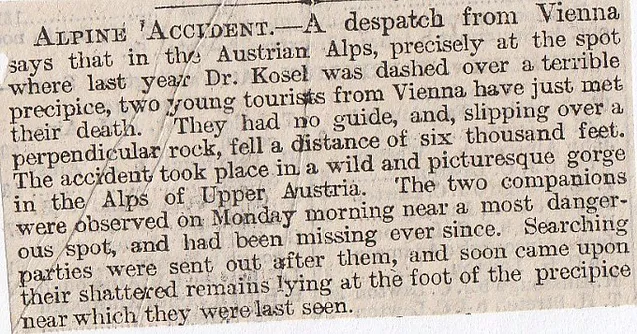
66/ Berlin, Germany, June 1891 (Romantic Suicide)
The gorgeous daughter of Lieutenant Rummelsburg, Miss Helene Hortung, killed herself “Cinderella style” at midnight, running from a ballroom. She fled the scene, down the road with half a dozen of her friends trying to catch up with her, but she made it to the lake first and plunged into the water. Two men jumped in to rescue her but by this time she had sunk to the bottom, probably due to the weight of the ball-gown. The reason for this theatrical performance? Well, her fiance and she had an argument and she ran off shouting that she was going to drown herself. Silly cow!
67/ Diano Arentino, Italy, September 1894 (Female Duel) (Near the French border)
Typical Italian tale of a man seeing another woman behind their backs. The two women in question though loved the man but didn’t know he was two-timing them. Eventually, it all came out in the open and the women developed a hatred for each other, so much in fact, that they decided on a duel to see which one would get their man. They met one day and chose knives for the duel. The two girls are only eighteen and twenty years old. When they met, the eighteen-year-old rushed at her love rival and stabbed the 20-year-old in the heart. A sudden pang of remorse hit her and realizing that she had murdered her, pulled the knife out her chest and immediately slit her own throat with the weapon. The pair were found dead, side by side, the teenager with the knife in her hand.
68/ Geneva Murder/Suicide, Switzerland, March 1885

69/ Berlin, Germany, June 1894 (Quadruple Murder/Double Suicide)
Karl Seeger was a successful painter who had accumulated a large fortune, but he had invested it in certain ventures and he might as well have flushed all his cash down the toilet. He lost the vast majority of his fortune and he and his wife brooded over their situation, which had put the family at near starvation. In a bizarre suicide pact they thought the only way out, and to save the prospect of poverty, was to kill the kids and then suicide. Rudolph aged nineteen and Bruno aged thirteen, ten-year-old Martin and Elizabeth aged seven, were given poison in some liquor and then to make doubly sure they hanged them. Mr and Mrs Seeger then sat down and took a dose of the poison, dying near the children they had callously killed.
70/ Starnberg Lake Suicide, near Munich, Germany, July 1914
Beautiful Lake Starnberg, over twenty-two square miles, was the scene of a very unusual suicide in 1914. Frau Von Der Heydt, whose husband was a well-known artist, was residing in a rented villa on the bank of this gorgeous lake. She asked a neighbour if her two daughters, aged ten and twelve, would like to go with her for a ride on the lake in a row-boat. The weather looked a bit dodgy, with storm-clouds gathering, but they rowed out on the calm waters about half a mile from the shore. Frau Von Der Heydt rose up and started taking her clothes off, then took a swig from a bottle, then to the horror of the two girls jumped into the lake and disappeared underwater. The two girls were in shock; shaking and barely able to talk, but some fisherman rowed them to shore where they explained what Frau Von Der Heydt had just done. Her body was washed up later that same day.
71/ Groscavallo Avalanche Adventure, Italy, February 1885
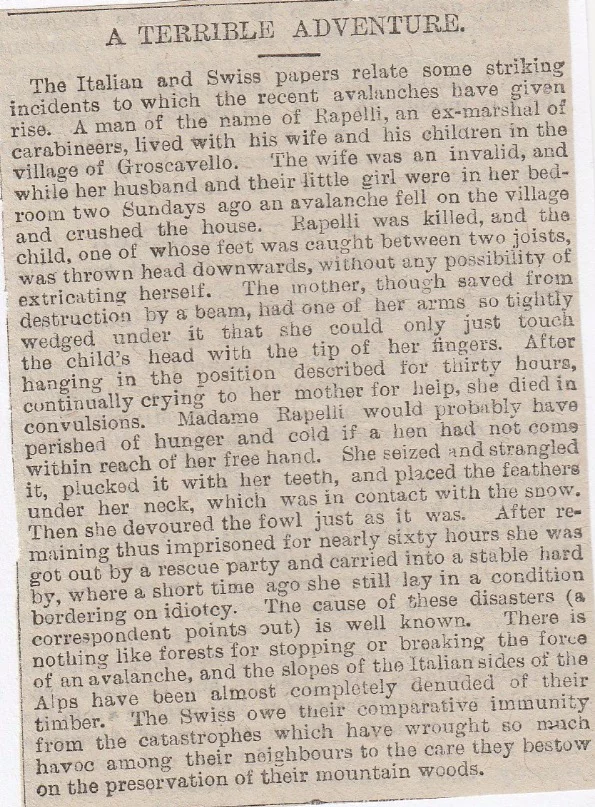
72/ Fuerteventura, Canary Islands, Spain, June 1896 (Body in a Suitcase)
Fuerteventura in the Canary Islands was the scene of an appalling discovery. Washed up on the beach was a massive suitcase, which when it was undone, was found to contain a smaller wooden box. Rather like a set of Russian dolls, there was a zinc box inside this one, which was waterproof and the contents of that was the body of a smartly dressed, beautiful young lady, adorned with expensive jewellery. I say she was gorgeous, I meant if she hadn’t got a huge gash in her eyes and her eyes plucked out. The woman was estimated to be late teens/early twenties, brunette, wearing a white bodice and black dress emblazoned with little red flowers, black stockings, no shoes and a pair of leather gloves. Her jewellery was gold and diamond encrusted. Nobody knew who she was.(Did they ever find out her identity?)
73/ Malaga, Spain, March 1885 (Boat Collision)

74/ Berlin, Germany, September 1908 (Train Crash)
Two trains crashed in Berlin on the electric elevated railway, with one of them being thrown into the street below and the other hanging on a parapet. Seventeen were killed on the spot, with dozens more badly injured. One fireman described seeing bits of human flesh hanging from the viaduct.Tthe accident was caused by one of the trains running a danger signal and many of the deaths were attributed to passengers coming into contact with the electric current. The railway ran from Westend to the Warschauer Brucke, making a loop of the Leipziger Platz. Every third train ran along the rails of the triangle, not touching the Leipziger Platz at all. This train hit another and the third class carriage was tipped over, about twenty feet down onto a courtyard of a warehouse near the Anhalter and Potsdamer Railway termini. (What was the death toll in the end?)
75/ Miramare/Trieste, Italy, June 1899 (Murder on a Train)

76/ Naples Double Suicide, Italy, December 1861
I suppose in a way you could say this is quite a romantic double suicide if there is such a thing. Mr Kenrick was an elderly married man who formed an attachment to a much younger Englishwoman, named Miss Gray. They moved around Italy, mainly in Rome and then to Naples. Kenrick had some wealthy relatives back home in England and sent letters asking them for money but they wholeheartedly ignored him, probably due to the fact he was wafting around Italy with a woman he could pass off as his daughter. They clearly loved each other because when it boiled down to it, they both agreed on suicide. They went to the cafe at Villa Reale, had a glass of rum, then climbed over a wall of the villa, past the semi-circle where the stone seats are and made it onto the beach. Miss Gray filled her dress with sand and tied it up around her ankles and Kenrick did likewise with his shirt, filling it with pebbles and sand in order to weigh himself down. After all this, they tied themselves together with their handkerchiefs and lay on the beach waiting or the tide to come in. Both bodies were found in the clear waters the next morning. Mr Kenrick’s life was insured for £3000, but because he killed himself the family wouldn’t get a single penny of it. (Are they buried in Italy?)
77/ Camphausen Pit, Saarbrucken, Germany, March 19th, 1885

78/ Camphausen Pit, Saarbrucken, March 20th, 1885 (near the French border)

79/ Estepona, (between Marbella and Gibraltar) (Englishman’s Body Found) December 1915


